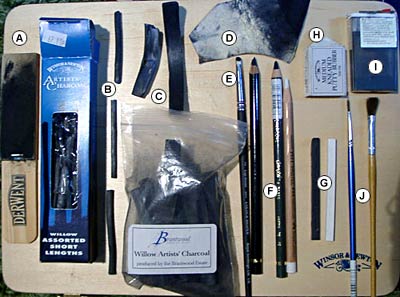How to Draw PeopleFemale Nude, Figure in Charcoal |
By Gavin B.
|
||||||||||||||||||||||||||||||||||||||||||||||
Female Nude in Charcoal, Part 1 of 3
Originally written by Gavin B. 2003 Learning how to draw people and figure art is exciting and challenging in any medium - in this short art lesson we will produce a fairly small rendering of the female nude in vine charcoal. My own brief experiences with this ill-behaved medium have met against some resistance, until recently and somewhat ironically, I found dust to be a solution. I tried an experiment by grinding charcoal into fine powdery form and then painting it onto the paper, with instantly improved results, and it is these techniques I would like to share with you now... How to Draw People - Human Figure in Vine CharcoalEquipment 


Left: Fixative- Brushing dry charcoal dust around with a brush makes it difficult to apply a dark tone in one take; spraying fixative allows me to build up two or maybe three layers to get the darker tones. The larger can was the cheapest I could find, and as a consequence I have to spray three times as much to get any use from it. My recommendation would be to invest in something half-decent. The Windsor and Newton fixative may be smaller, but it is much more effective and ultimately lasts longer. Right: Paper- You can use any paper from pastel paper (Canson is particular good from my previous pastel painting efforts), watercolour paper to bristol board. For the purposes of this article I have bought a pad of Charcoal Paper made by Daler-Rowney. It is 'laid' paper, giving it a texture that helps hold the charcoal, and is slightly tinted. 
Creating DustThis is the messy (and fun) part! With your vine charcoal in hand, sand it down over a piece of folded paper (I've used an old envelope). If you do not have any spare sandpaper, you should still be able to create dust by rubbing your charcoal on a piece of paper. Take caution not to breathe in the dust. You will probably need to obliterate two sticks, and once done carefully pour the dust into a container for safekeeping. 
Making a PointWhen drawing people, facial details can be very fiddly when working small and working in charcoal as it does not have the pinpoint accuracy of a sharpened pencil. If you rub it down you can form a sharp edge for more detailed work. Do not expect the sharp edge to last long though. Lesson continues, follow link below... Click to View PART TWO of the FEMALE FIGURE DRAWING art lesson
|
|||||||||||||||||||||||||||||||||||||||||||||||
Charcoal Lessons
Charcoal |








